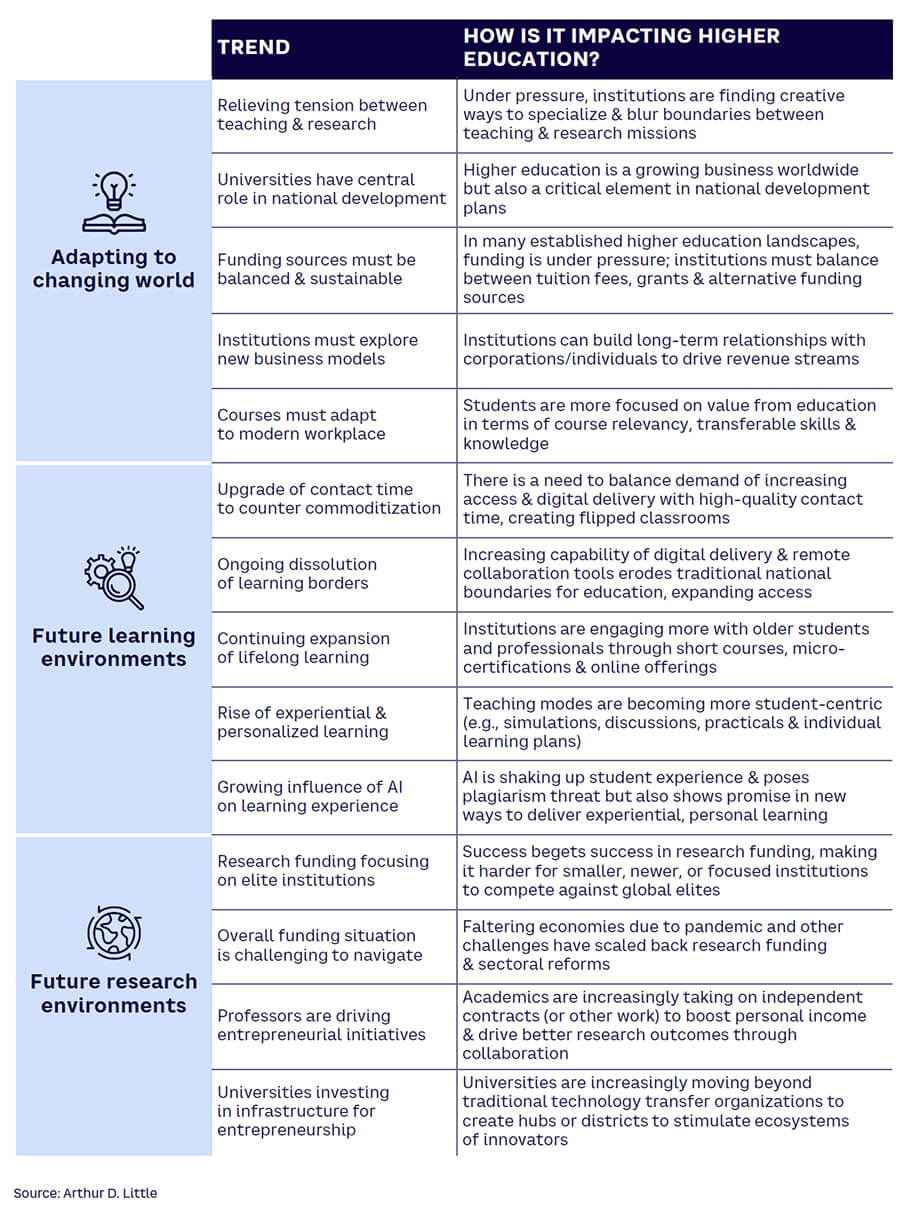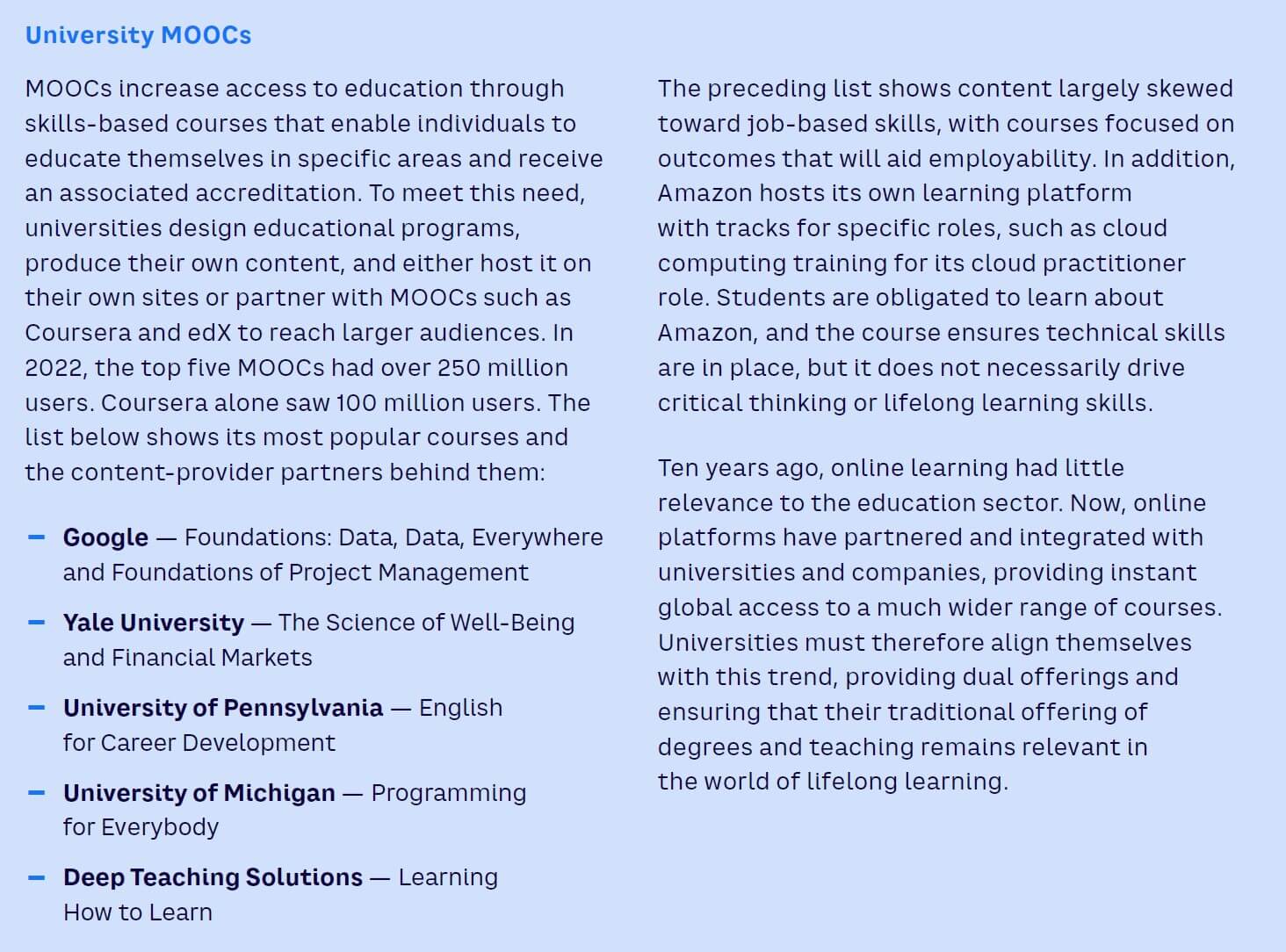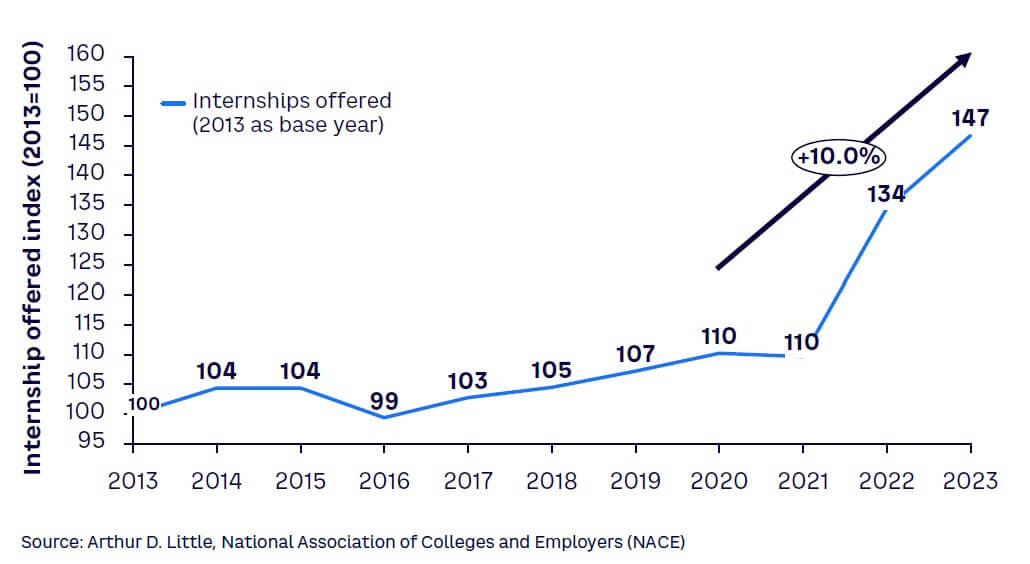Since the turn of the millennium, modern universities have adapted and evolved from their public image as traditional old institutions of knowledge. However, they currently face a widening range of challenges brought on by our transforming, globalized world.
Universities must balance the conflicting demands between their traditional mission of teaching and research, while distinguishing themselves within a deepening pool of quality competition in an increasingly borderless market.
On the research side, funding is becoming more concentrated among a smaller group of institutions, but funding models are complex and can change rapidly. Universities are stepping up to share research and play their part in solving current global mega-challenges, driven by increasingly entrepreneurial academics and a focus on new ways of building innovation ecosystems to drive greater commercial relevance and revenues. On the teaching side, the pandemic’s impact on teaching hastened the rise and reach of digital learning — but it also underscored the value of experiential and personalized approaches to study.
Breakthroughs in artificial intelligence (AI), and the rise of commoditized online courses from nontraditional providers, increase pressure on universities. They must deliver quality differentiated teaching to a wider range of students who are looking to invest in lifelong learning and build skills over a longer (or shorter) period than the traditional four-year degree. Student needs are changing, and they increasingly demand a return on the time and money they invest in tuition.
The above conditions mean that individual institutions need to make strategic decisions around their future. Universities need to embrace changes in both how they are structured and how they operate and teach. They must reexamine their strengths in a global context and rethink traditional models around their missions of research and teaching to find their place in a changing world.
In this Report, we analyze the current context, describe the trends driving the higher education environment, and outline potential options for the future, based on a combination of Arthur D. Little (ADL) case work, sector knowledge, and interviews with thought leaders in education.

While the pandemic forced an overnight change in the delivery of university teaching, in many ways it simply turbocharged an existing shift toward digital learning, which caused many students and institutions to question how and where learning should take place. This rebalancing is still playing out, driving innovation in course delivery against a backdrop of a greater focus on improving the quality of in-person learning, lifelong learning, and nontraditional teaching options. What will the teaching mission of universities look like in the future?
Since the pandemic required universities to go digital for lectures, seminars, and other learning experiences, there has been a reluctance to fully return to in-person instruction. This comes from both academic and student perspectives to differing degrees and links to changing student needs and a desire to maximize contact time.
While delivering university courses digitally enables institutions to scale up the number of students they can teach (thereby increasing revenue), virtual learning also brings challenges. It increases competition from universities at home and abroad and can lead to a degradation of teaching quality when there’s little to no upgrade in value of in-person time. Teaching institutions must ensure that even brief amounts of contact time with students maximizes the value of their learning. This may lead to “flipped” classrooms: lecture content delivered online but with greater efforts placed on highly interactive tutorials delivered to small groups.
As costs rise and students continue to question the economic value of a university education, there will be a much greater focus on teaching quality and the amount of in-person learning and its ability to affect future job prospects and build transferable skills.
The ongoing digital transformation of education provides significant opportunities for universities. It enables students from around the globe to effectively participate in learning activities, while removing constraints on scale in areas such as teaching facilities and student accommodations.
The last few years have shown that most lecture-based teaching can be delivered online. From that perspective, there’s little difference between a student’s bedroom in Cambridge or Santiago. The pandemic’s impact cannot be overstated. In the US, the number of undergraduate students exclusively enrolled in distance education courses was 186% higher in 2020 than 2019 due to the impact of COVID-19.[1] Importantly, those numbers have not changed much in the semesters since.
On the positive side, online learning has the potential to democratize access to some elite universities that have previously been unattainable due to high fees, travel costs, visa or residency restrictions, or living expenses in university towns such as Oxford. If universities wish to democratize learning, then borderless, digital delivery seems like an obvious enabler.
Distance learning is not new; the UK’s Open University began its primarily distance-learning programs in 1969. However, the continued growth of Web collaboration tools — video calls, virtual whiteboards, simultaneous-editing software, and potentially aspects of the Metaverse — further erodes the perceived barriers to educational delivery from afar. How institutions manage this shift and balance the physical and digital sides of their teaching mission will have fundamental impacts on their student numbers, revenues, and their ability to recruit potential researchers and academics in the future.
Today, people studying for a first degree are expected to change careers three to five times during their working life. One impact of this is a renewed drive for lifelong learning and upskilling in the professional workplace: applications to both online and in-person MBAs were up over 20% in 2021.[2] Global workplaces recognize that training and continuing professional development are key to attracting and retaining talent. Employers generally see this as a win-win; their employees gain skills, perform better, and have more reasons to remain with their employer. As technological inventions continue to change the modern workplace (witness the ongoing AI revolution), all employees will need to regularly learn new skills.
To meet their learning and development goals, many businesses have established partnerships with online educational content providers such as LinkedIn Learning, Kubicle, and Udemy. These courses range from basic topics, such as how to get the most out of spreadsheet software to more complex courses that delve into project management, sales, and business leadership. However, while the vast range of available options rewards the curious, these courses provide a relatively passive learning process that culminates in a quick test at the end of a video module. The student may engage with the course, but the actual learning reward is low.
In parallel, universities have gradually expanded the availability of massive open online courses (MOOCs), with educators from elite institutions adding more and more courses to platforms like edX and Coursera. In many cases, these courses are provided gratis or funded by modest accreditation fees from successful students. However, even within the academic field, the focus of course content has traditionally been around specific, job-related skills like business management and digital technology specialties such as data science. Relatively few rigorous options exist for ongoing and lifelong learning in core academic subjects — pure sciences, history, philosophy, literature — whether the goal is to build degree-equivalent knowledge or explore a new interest with the goal of becoming a more well-rounded individual.
Despite the boom in distance-learning, few options are available for professional or lifelong learning that fit around work schedules in the same way as an executive MBA, which combines intense, residential courses interspersed with distance learning over a multiyear period. This blueprint shows a way forward for universities and could even be enhanced through collaboration across institutions, allowing more open access to learning environments and providing micro-credentialed courses that over time may result in a degree. In this paradigm, a completed degree is not always necessary for lifelong learners, whose needs and interests may change depending on their current job, projects, and capability gaps. It is therefore important to allow for short or extended breaks, with flexible commitment and options to transfer credits gained into a foundation degree or other diploma.
All this means that universities need to innovate by offering options for shorter courses to capture interest and tuition dollars from the growing number of lifelong learners. Failure to do so will potentially undermine access to a lucrative, long-term teaching opportunity, which other international institutions or online-first players like LinkedIn Learning could capture. The sidebar “University MOOCs” lists some nonacademic content partners and the courses that generated the most interest.

Experiential learning, which puts theory into practice, continues to grow. Rather than sitting in a lecture room or checking in online to passively absorb information, students are actively involved in learning and given the chance to explore and reflect on topics in a variety of situations: group discussions and projects, simulations and practicals, field exercises, and independent research, among others. Experiential learning has been shown to improve student satisfaction and understanding of key course materials,[3] as well as increasing the quality of in-person classes and improving students’ perceived value for the money.
The experiential approach is already common in certain settings, such as business schools, where case discussions, simulations, and project work (often examining real problems from real businesses) are the norm.
Experimental practicals have been part of science subjects and medicine since antiquity. Law students hold moot courts and mock trials to learn the art of argument and understand the reality of interpreting statutes. These opportunities help students apply their knowledge far beyond their theoretical understanding of course materials.
There are a multitude of ways to increase the use of experiential learning in the classroom, with different, potentially competing, pedagogies, such as problem-based learning, action learning, and simulation learning. Each approach focuses on a set of tools the educator can use to empower their students and help them learn more effectively.
There is a clear and growing trend to extend experiential learning to other settings. For instance, history students at Queen’s University in Kingston, Ontario, Canada, are offered the opportunity to gain degree credits through internships as archival and research assistants within the university or with a variety of partner museums. Similar programs at other universities may focus on capturing oral histories or curation. Universities, and more importantly, employers, are encouraging students to engage in internship programs, with employers expecting to offer 9.1% more internships in 2023 following an already-substantial increase of 22.6% in 2022 (see Figure 1).[4] These programs act as differentiators for courses, drawing in a wider set of students and also, in theory at least, hitting that key modern KPI for universities: graduate employment rate.

At least to some degree, the growing rise of experiential learning is in opposition to the trend of increased digitalization. In its most common form, structured classroom discussions, experiential learning puts face-to-face student interactions at the forefront of teaching. This type of interaction was most challenged by the pandemic-enforced swit